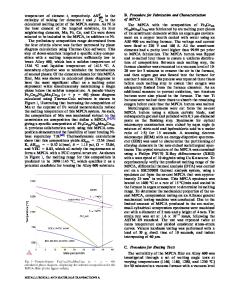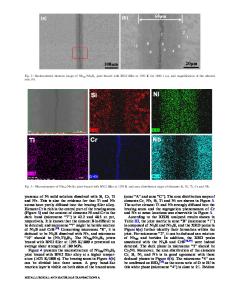Microstructure and Mechanical Properties of a SiO 2 Ceramic and TC4 Alloy Joint Brazed with a Nanocomposite Filler
- PDF / 7,300,408 Bytes
- 7 Pages / 593.972 x 792 pts Page_size
- 14 Downloads / 353 Views
JMEPEG (2019) 28:4427–4433 https://doi.org/10.1007/s11665-019-04147-3
Microstructure and Mechanical Properties of a SiO2 Ceramic and TC4 Alloy Joint Brazed with a Nanocomposite Filler Hong Bian, Qi Zhang, Yanyu Song, Duo Liu, Jinghe Liu, and Xiaoguo Song (Submitted November 7, 2018; in revised form March 28, 2019; published online June 24, 2019) Vacuum brazing of TC4 alloy and SiO2 ceramic was achieved using a nano-AgCuNi braze alloy. The melting temperature of nano-AgCu powders was analyzed by differential scanning calorimeter. Furthermore, the effects of the Ni content on the microstructure and mechanical properties of the joints were studied. The results showed that the melting temperature of the nano-AgCu filler was 774 °C. A decrease in the melting temperature of 6 °C was observed, compared with the general AgCu filler, and this decrease enabled the interfacial reaction of the joint to begin earlier. The typical interfacial microstructure of the TC4/nano-AgCuNi/SiO2 ceramic joint brazed at 950 °C for 10 min was TC4/a-Ti + Ti2(Cu,Ni) + Ti2(Ni,Cu) hypereutectoid structure/Ti2(Cu,Ni) compound with a-Ti + Ti2(Cu,Ni) + Ti2(Ni,Cu) hypereutectic structure/Ti4O7 + TiSi2/SiO2 ceramics. The homogeneous microstructure of a-Ti + Ti2(Cu,Ni) + Ti2(Ni,Cu) hypereutectoid structure primarily existed in the diffusion layer. Additionally, the refined aTi + Ti2(Cu,Ni) + Ti2(Ni,Cu) hypereutectic structure created via a eutectic reaction and Ti2(Cu,Ni) compound was distributed in the brazing seam. The Ni content could influence the formation of Ti-Cu-Ni ternary intermetallic compounds (IMCs). An increase in Ni led to an increase in the a-Ti + Ti2(Cu,Ni) + Ti2(Ni,Cu) hypereutectic structure in the brazing seam. The shear strength of the brazed joints first increased and then decreased with the increase in the nano-Ni content, and the optimal shear strength of 30.1 MPa was achieved at 10 wt.% Ni. The increase in the a-Ti + Ti2(Cu,Ni) + Ti2(Ni,Cu) hypereutectic structure and the decrease in brittle compounds enhanced the shear strength of the joint. Fracture analysis of the joints brazed at 950 °C for 10 min indicated that the cracks mainly occurred in SiO2 ceramic. Keywords
brazing, ceramic, mechanical properties, nano-sized composite filler, SiO2, TC4
1. Introduction As a material that is increasingly applied in engineering components, nanoparticles have particular surface effect, volume effect and quantum size effects (Ref 1-4). Nano-sized composite filler is distinguished from micro-sized composite filler due to its greater surface-to-volume ratio and larger interfacial area (Ref 5, 6). SiO2 ceramic exhibits excellent mechanical properties, such as high stiffness, excellent thermal resistance, good corrosion resistance and superior thermal
Hong Bian and Yanyu Song, School of Materials Science and Engineering, Harbin Institute of Technology, Harbin 150001, China; State Key Laboratory of Advanced Welding and Joining, Harbin Institute of Technology, Harbin 150001, China; and Shandong Provincial Key Lab of Special Welding Technology, Harb
Data Loading...











